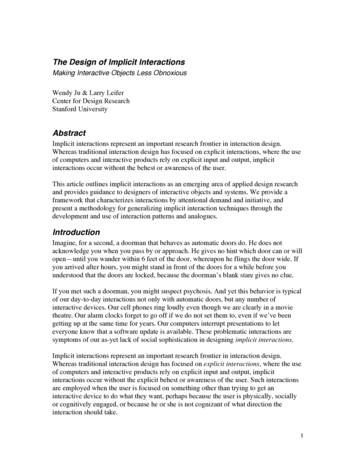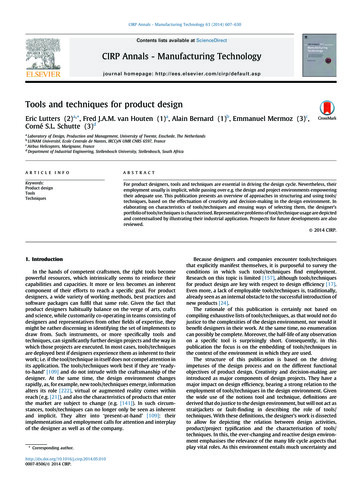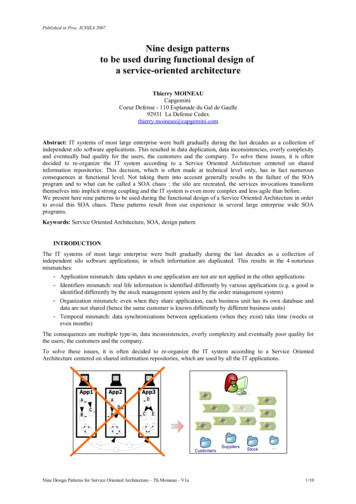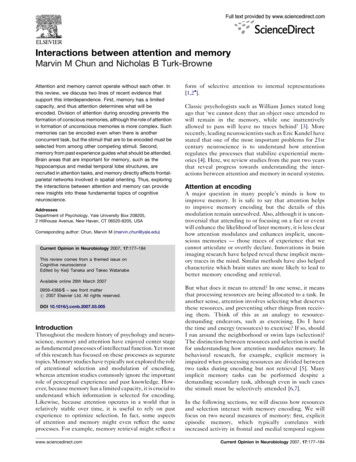
Transcription
thing newThe Design of Implicit InteractionsMaking Interactive Objects Less ObnoxiousWendy Ju & Larry LeiferCenter for Design ResearchStanford UniversityAbstractImplicit interactions represent an important research frontier in interaction design.Whereas traditional interaction design has focused on explicit interactions, where the useof computers and interactive products rely on explicit input and output, implicitinteractions occur without the behest or awareness of the user.This article outlines implicit interactions as an emerging area of applied design researchand provides guidance to designers of interactive objects and systems. We provide aframework that characterizes interactions by attentional demand and initiative, andpresent a methodology for generalizing implicit interaction techniques through thedevelopment and use of interaction patterns and analogues.IntroductionImagine, for a second, a doorman that behaves as automatic doors do. He does notacknowledge you when you pass by or approach. He gives no hint which door can or willopen—until you wander within 6 feet of the door, whereupon he flings the door wide. Ifyou arrived after hours, you might stand in front of the doors for a while before youunderstood that the doors are locked, because the doorman’s blank stare gives no clue.If you met such a doorman, you might suspect psychosis. And yet this behavior is typicalof our day-to-day interactions not only with automatic doors, but any number ofinteractive devices. Our cell phones ring loudly even though we are clearly in a movietheatre. Our alarm clocks forget to go off if we do not set them to, even if we’ve beengetting up at the same time for years. Our computers interrupt presentations to leteveryone know that a software update is available. These problematic interactions aresymptoms of our as-yet lack of social sophistication in designing implicit interactions.Implicit interactions represent an important research frontier in interaction design.Whereas traditional interaction design has focused on explicit interactions, where the useof computers and interactive products rely on explicit input and output, implicitinteractions occur without the explicit behest or awareness of the user. Such interactionsare employed when the user is focused on something other than trying to get aninteractive device to do what they want, perhaps because the user is physically, sociallyor cognitively engaged, or because he or she is not cognizant of what direction theinteraction should take.1
The infiltration of computer technologies into everyday life has brought the need forimplicit interaction techniques to a head. As Neil Gershenfeld observes, “There’s a veryreal sense in which the things around us are infringing a new kind of right that has notneeded protection until now. We’re spending more and more time responding to thedemands of machines.”1 It is clear that we cannot interact with computer devices in a carthe way that we do with our desktop computer—but how should we interact with thedevice while we are driving? We all recognize that the computer need to be less needy ofour attention when we are in a meeting, or on the phone, but how do we make these lessneedy interfaces?This article outlines an emerging area of applied design research2 and provides guidanceto early designers of implicit interactions. To this end, we provide a framework by whichto better understand implicit interactions, and present a methodology for designingimplicit interactions. Because different kinds of implicit interactions share commonalityacross different domains and scenarios, we posit that it is possible to generalize implicitinteraction techniques through the development and use of interaction patterns andanalogues.ApproachIronically, implicit interactions are challenging to design in large part because we humansare so adept at using them. We successfully employ them in our daily interactions witheach other without conscious thought: We modulate our speaking volume based onambient noise level, use smaller words when explaining things to children and hold thedoor open for others when we see that their arms are full. These accommodations help tomanage attention, govern expectations, and decrease cognitive load. They do much tosmooth our day-to-day interactions with one another, and yet, are made without explicitcommand. 3One goal in our approach to the design of implicit interactions is to leverage this knowhow that humans have about interacting with one another—and to enable designers toshare this knowledge with one another. Just as toolkits provide a common architectureand library for software developers working on similar classes of applications4, weprovide a common framework and methodology for designers to use in designing implicitinteractions. By outlining a design method that is useful in creating a broad class ofinteractions, we seek to complement technology-based approaches (which focus, forinstance, on sensors and architectures that enable implicit interaction), or analysis-basedapproaches (which would investigate implicit interaction through studies and controlledexperiments) towards implicit interaction design.Many researchers working in the areas of ubiquitous computing and pervasive computingare focused on how to solve these problems by making devices “smarter.” But theseapproaches give short shrift to the richness of human interactions. They focus on being“logical” rather than “courteous.” What if our true talent as human interactants is less awealth of intelligence so much as a measure of suave?2
A Framework for Characterizing Implicit InteractionsFor the most part, interaction designers have come to rely on a variety of designprinciples and heuristics to design implicit interactions. Cooper and Reimann’s AboutFace 2.0, for example, provides the following guidance for designing consideratesoftware: “Considerate software takes an interest. Considerate software is deferential.Considerate software is forthcoming. Considerate software anticipates needs. Consideratesoftware is conscientious. Considerate software doesn’t burden you with its personalproblems. Considerate software keeps you informed. Considerate software is perceptive.Considerate software is self-confident. Considerate software doesn’t ask a lot ofquestions. Considerate software takes responsibility. Considerate software knows whento bend the rules.”5 This is not bad advice, but these guidelines do not actually instructdesigners when an interactive object should take an interest, and when it should not ask alot of questions. It is more useful to have a map characterizing interactions so thatdesigners can more easily reason about what degree of implicitness or explicitness isdesired in the situation they are designing, and how they might create the appropriateexperience.Figure 1. The Implicit Interaction Framework shows a rangeof interactive object behaviorFigure 1 shows an implicit interaction framework that characterizes different types ofinteractions based on two dimensions: attentional demand and initiative. Bycharacterizing implicit interactions by the initiative shown by the actor and the attentiondemanded of the other interactant, we are able to generalize about the capabilities andfeatures of whole classes of interactions in a domain-independent fashion.3
It can be come confusing, in discussing the transactions between two actors, to determinewhose attention and initiative we are speaking of in this framework. Therefore, let usdefine our interactions as occurring between object and user. In this case, the object mayactually be a human, a computer, a door, or a voice on the phone. The object representsthe thing whose actions we can design. As designers, we adopt the object’s perspectiveon the interaction. The user is presumed to be the object’s partner in interaction, who thedesigner has no direct control over. The user is usually a human, but could as easily be adog, cat or any other autonomous being. When we speak of attentional demand in Figure1, we actually mean the attention demanded by the object from the user. When we speakof initiative, we speak of actions or presumptions made by the object toward, about oraround the user.The following are descriptions of interactions typified by each quadrant. The intent is tocharacterize rather than to define categories:The Framework, AppliedTo better understand the range of implicit interactions, let us consider this example: Ourfriend Terry sends us a link to a funny animation that can be found online. To play theanimation, we need a Macromedia Flash plug-in installed on our computer. Thefollowing cases show different ways that the plug-in can come to be installed:CASE 1: We see that the animation does not work. We deduce that we need theplug-in. We find, download and install the plug-in.4
This is a classic example of explicit interaction. This is far from a unilateral activity onour part, for the computer is involved throughout this process, but we are activelyengaged in diagnosing, deciding and performing each step along the way.CASE 2: We see that the animation does not work. We deduce that we need theplug-in, and ask the web browser to find, download and install the plug-in.CASE 3: Our web browser shows that our animation does not work because weare missing a plug-in. We find, download and install the plug-in.The second and third cases highlight the different ways interactions can be implicit. Incase 2, we actively perform the task of problem observation and diagnosis, but theindividual steps of getting the plug-in installed are abstracted away so we don’t have toattend to each step. In case 3, the browser proactively identifies the problem andsuggests a solution, although we have to go through the steps to implement it.Case 2 is an example of abstraction; the plug-in installation occurs in the background, sothat we don’t have to actively and explicitly perform each step. Case 3 is an example ofalert, where the interaction is implicit in that the system proactively diagnosed andinformed me of the need for the plug-in. These cases illustrate how attentional demandand initiative affect the implicitness of the interaction.CASE 4: Our web browser shows us that our animation does not work and offersto find, download and install the plug-in. We accept the offer, and the plug-in isinstalled.CASE 5: Our web browser sees that we are trying to play an animation that we donot have the plug-in for, and lets us know that it is automatically finding,downloading and installing the plug-in.CASE 6: Our web browser sees that we are trying to play an animation that we donot have the plug-in for, and automatically finds, downloads and installs the plugin as a background process.These three cases show increasing degrees of proactivity and presumption on the part ofthe web browser, and decreasing degrees of attentional demand. In case 4, there is a fairamount of demand on our attention because we need to actively accept an offer. In cases5 and 6, the plug-in is installed without any activity on our part, but the last case is moreimplicit because no feedback is offered. Although our actions in both cases are the same,the case 6 is more presumptuous because we do not have the opportunity to oversee andpossibly cancel the task.CASE 7: Our web browser anticipated that we might want to play a Flashanimation someday, and has already downloaded and installed the plug-in.This last case is the most implicit interaction; in fact, with so much presumption and solittle visibility, this last interaction may hardly be considered an interaction at all, sincethere is no activity or awareness on our part.5
There is a range of ways to accomplish the task of installing the Flash plug-in withdifferent degrees of attentional demand and proactivity. Which is the best? It depends alot on the situation: How capable is the user of installing this plug-in? How much controldoes the user want over disk space or network bandwidth? How concerned is the userabout security? Just how funny is this animation Terry sent, anyway? Most plug-insemploy a design like the one in case 4 because it provides a happy medium.As this example shows, although we speak of “implicit interactions,” it is more accurateto speak of interactions being more and less implicit. Within the course of a task,different aspects of the interaction—the diagnosis, the action, the feedback—may bemore or less implicit. Even though this example reflects a human-computer interaction,the issues that we raised around the implicitness are reflective of the style of thetransaction rather than the characteristics of the computer, and hence transcend humancomputer interaction to interaction in general.Now, let us examine the two dimensional variables in greater depth:Attentional DemandOn face value, attentional demand is easy to understand. Foreground interactions requirecognitive or perceptual “focalization, concentration and consciousness.” 6 Backgroundinteractions do not make such demands, and in fact, elude notice.Upon deeper scrutiny, the simplicity of the definition breaks down. We also need accountfor spatiality (as Goffman did in drawing a distinction between “frontstage” and“backstage” interactions), breadth (with many stimuli or just one), or intensity, amongother things. This complexity occurs in large part because our understanding of attentionitself is still fairly limited. Cognitive neuroscientists are coming to feel that what we callattention is actually a catch-all grouping of widely diverse mental functions andphenomena.7 However, since a broad, commonsense understanding of attention allows ussufficiently to reason about and plan our interactions with other humans, it is reasonableto assume that it is operationally sufficient to design with.Interaction designers commonly manipulate attentional demand by adjusting theperceptual prominence of objects. This may be done through visual organizationtechniques, such as contrast, hierarchy, and weight.8 It may also be done through moredynamic means, such as pointing, or placing.9 Interaction design research on the use ofsuch techniques to present data calmly to users engaged in some other task has beenpursued at the MIT Media Lab10 and Berkeley’s Group for User Interface Research,11among others.Another way to affect the degree of attention demanded is through abstraction. Withabstraction, atomic interactions are combined into a larger whole, so that the user ispresented with less detail. Abstraction is related to chunking, wherein experts are able tocomprehend complex situations (such as the state of a chessboard) with greater easebecause they are able to parse the scene into familiar subcomponents.12 Gestaltpsychology has demonstrated that this process of chunking leads an “integrating of6
awareness” where people are able to identify a whole (say, a particular person’s face)without being able to identify the details that make up the whole.13 Whereas abstractionimplies an extrinsic manipulation of representation, the phenomenon of chunking isintrinsic to the user.One final and often overlooked aspect of attentional demand is expectation. Since whatpeople tend to notice most are discrepant objects and events, it is possible to demandattention by deviating from expectation, and to relinquish attention by conforming toconvention. This introduces the problem of having to understand what the “ prevailingstandards of decorum”14 are in any situation we are designing for. This also explains oneof the most challenging aspects of introducing innovative objects that are meant to be“invisible”; they are new and unexpected, and so people tend to focus on them.This discussion of attentional demand may resonate with those familiar with BillBuxton’s concept of attentional ground15: “What we mean by Foreground are activitieswhich are in the fore of human consciousness - intentional activities. Speaking on thetelephone, or typing into a computer are just two examples.” Buxton’s definition offoreground only overlaps with the left half of the implicit interaction framework; becausehe only considers the realm of user-initiated interactions—typing into a keyboard, orswitching on a light—Buxton’s definition conflates attention with intention. Thisdefinition is inadequate for describing device-initiated interactions—a cell phone ringing,or an automatic door opening. These interactions clearly take place in the foreground butare not at all intentional on the part of the user. Decoupling attention from intention givesus a separate dimension, initiative.InitiativeThe distinction of who initiates an interaction is important one in defining itsimplicitness. If a waiter refills your coffee because you ask him to, that is a reactiveresponse to your explicit request. However, if the waiter refills your cup because he seesthat it is empty, this interaction becomes implicit; even if the proactive act of pouring thecoffee might be in your attentional foreground, the waiter is responding to a projectedrequest for more coffee.This range of initiative from reactivity to proactivity exists within a larger spectrum. Onthe one end is direct manipulation, where the object is a tool with the potential to be anextension of the user. On the other end is autonomy where the object acts on its ownwithout input or intervention. Both extremes have been presented as ideal goal states;interestingly enough, neither are salient to this discussion. Autonomous objects are notpertinent to interaction design because there is no interaction to speak of. In directmanipulation, when the object is ready to hand, there exists a one-to-one mappingbetween what the user intends and the action that ensues. As Winograd and Floresobserve, “You do not think ‘How far should I turn the steering wheel to go around thatcurve?’ In fact, you are not even aware (unless something intrudes) of using a steeringwheel. Phenomenologically, you are driving down the road, not operating controls.”16This type of ready-to-handness has steep requirements, however, as the user needs to be7
fully engaged, often mentally and physically; it does not scale well beyond expert users,or to control of multiple objects or background tasks.Initiative is salient in situations where actors are working together to accomplish a task.From the perspective of those championing direct manipulation or autonomy, joint actionis suboptimal because it requires negotiation and coordination. However, it is far easier tothink of successful examples of joint actions than terrific tools or perfectly autonomousobjects. “Every day we engage in activities in which we have to coordinate with others tosucceed,” says Herb Clark. “Face to face, we have systematic, economical and robusttechniques of arranging for joint activities.”17 One can even argue that we can experiencereadiness-to-hand in interaction with others; certainly we can contrast the ease andtransparency with which we can buy a shirt at Macy’s with the tortuous process of buyingthings in a foreign country with a different language and customs. In fact, it is possible toimagine optimal interactions at every point along the initiative continuum; the challengeis knowing what interaction is appropriate for the situation at hand.The concept of initiative was introduced to interaction design by Eric Horvitz, who mayhave borrowed the variable from the realms of linguistics and explicit dialogue systems.Horvitz terms the interplays between proactive and reactive actions mixed-initiative: “Inmixed-initiative interaction, both users and computers take turns in contributing to aproject or an understanding.”18 Proactive objects operate in a realm of greaterpresumption, and so it is common that they need ways of seeing, discerning andreasoning about the world.19 This explains why most forays into proactivity, such as theresearch performed at Microsoft Research, 20 University of Karlsruhe21, and GeorgiaTech22, have been oriented on the technological issues of sensing, aggregating data,developing user and task models, and performing inference.And yet the solution for proactivity cannot lie in technology alone. People, for all theirvaunted intelligence, make inference mistakes all the time, and are usually forgiven. Whyis it, then that interactive products such as the Microsoft Office Helper are so roundlycriticized for guessing incorrectly what users are trying to do? It is probably becauseClippy is untrained in the art of what Erving Goffman calls “facework”, sometimes calledsocial graces, savoir-faire, diplomacy or social skill.23 When people go out on a limb,taking initiative in the face of uncertainty, they engage in compensating measures,hedging their actions with techniques such as overt subtlety (where actors make a showof how unobtrusive they are trying to be) or pre-emptive apology (where actors may bowtheir head, scrunch up their faces or raise their shoulders as they execute an action toindicate an apology if their initiative is unwelcome). One could easily imagine, forinstance, that recent research on interruptions at Carnegie Mellon24 and MicrosoftResearch,25 which have focused primarily on when to interrupt could be complimentedby research on how to interrupt. There are conventional ways to act proactively, even inthe face of uncertainty, and these are a matter of sociable design rather than technologicalintelligence.8
Implicit Interaction Design MethodologyOur design methodology for implicit interactions is for people to base the design ofinteractive objects on the habitual and standardized practice of day-to-day interactions.26To formalize the methodology, we present two important tools: first, the interactionpattern, which is a representation of standard interactions shared between participants,and second, the interaction analogue, which enables designers to borrow the techniquesfound in one interaction pattern to use in another.Interaction PatternsTo understand the role of interaction patterns in implicit interaction design, it is firstcritical to appreciate the importance of convention to both dimensions of implicitinteraction. Conventional statements and actions draw far less attention than dounconventional ones: The routine “How do you do?” is a lot less provocative than thesemantically equivalent “What is the state of your general well-being?” Similarly,following convention when exerting initiative or accepting an initiated interaction isnecessary to prevent interactional “break-down.”The patterns of day-to-day activity which we seek to represent have been studied before,by those in other disciplines. Sociologists, for instance, represent what Goffman calls the“strips of activity” as detailed narratives, setting the general context and describingspecific behaviors.27 Artificial intelligence researchers, such as Roger Schank and RobertAbelson, choose to use “scripts”—predetermined, stereotyped sequences of actions thatdefine well-known situations. Hoping for something more detailed and prescriptive thanthe description offered by Goffman, and something more human-legible than the scriptscreated by Schank and Abelson, we have opted instead to use conventions from the realmof theatrical performance.These interaction patterns differ from pattern languages used in interaction design. Theyshare some common ground in that they aim to provide templates for solutions thatdesigners can share with one another. However, design patterns suggest fairly high-levelapproaches to specific classes of design problems and are based on previous successfuldesigns. Our interaction patterns provide detailed instructions for the oft-implicitcommunications between actors, and can be derived from observations in the world.This section examines the key components of our interaction patterns—settings, roles,and sequences—in detail.SETTINGSThe setting is the context in which in interaction will occur. The setting is importantbecause it determine how we act, and how we interpret the actions of others. In additionto providing context, the setting is also an environment that may have structures or propsintended to support the interactions that are expected there.At a grocery store, for example, I put the groceries I wish to buy on the checkout counter,and keep the things I purchased before entering the store in my handbag; this drawsattention to the items I wish to interact with the grocery clerk about, and draws attention9
away from the items that might otherwise confuse the situation. The checkout counter hasa line, and I know that I cannot engage in barter until I reach the front of the line; thephysical structure of the counter helps to define who is the GROCERY CLERK, who isthe PAYER, and who is a WAIT-ER.As designers, we can create settings, defining the physical, visual or spatial environmentin a fashion so as to disambiguate what is to be interpreted from presence, location ororientation. We give important actions prominence so that they are more easily perceived,and dim unimportant ones so they do not distract. We privilege certain locations with theability to determine the roles of the actors. And of course, we provide ample room for theinteraction to play out.ROLESIn the previous example, the GROCERY CLERK, PAYER, and WAIT-ER are all roles.A role represents the relationship actors have in the interaction. As Goffman noted,“whenever an individual participates in an episode of activity, a distinction will be drawnbetween what is called the person, individual or player, namely, he who participates, andthe particular role, capacity and function he makes during that participation.”28Sometimes, the roles have goals and states associated with them. For example, if we castthe roles in the grocery store example as CLERK and CUSTOMERS, then bothCUSTOMERS would have the goal of obtaining goods, and the CLERK would have thegoal of obtaining money. The CUSTOMER at the head of the line is in the state ofPaying. The next CUSTOMER is in the state of Waiting.Roles are often communicated implicitly, through behavior, location and dress. Inhuman-computer interactions, the roles are so often COMPUTER and USER that we losesight of the fact that in other contexts, roles need to be clearly communicated to helpquickly and efficiently set up expectations about the nature of the interaction to come.Other examples of familiar role pairs are DRIVER/NAVIGATOR, andSTUDENT/TEACHER. Roles need not be filled by agentic characters—a compass canbe a navigator, and a vending machine can act as a server—but they do need to fulfill thetasks that are their raison d’etre.SEQUENCEThe sequence is the order of events that occurs in the course of the interactions. Forimplicit interactions, it is important that the sequence be very detailed, capturing not onlywords but also gestures and looks of the actorsFor a interaction sequence model, we borrow the pattern suggested by Henning Nelms forperforming an illusion in Magic and Showmanship: A Handbook for Conjurers:291. Interest-catcher: This commands attention and directs it into the routine.2. Introduction. Once attention has been gained, you must definitely establish theproper atmosphere and fix both your role and that of your audience.10
3. Statement of Theme. The statement should be a summary in one or two sentencesof ideas already explained in the introduction.4. Kickoff point. There is always a point where the performer stops dealing ingeneralities and commits himself to some positive action.5. Preliminaries. The apparatus is introduced, explained and rigged during this stage.6. Instructions. Spare no effort to make them brief, clear and foolproof.7. Action. This is the exhibition proper.8. Effect. Ideally this should be short and come as a climax.9. Ending. This covers the period form the end of the effect of the point where somecompletely new subject is introduced.What is interesting about this sequence is that the trick at the heart of the illusion—theaction—is sandwiched between many steps that a less conscientious magician mightoverlook. The early steps of the illusion serve to “ground” the interaction by garneringattention, defining roles, and establishing expectations for the action to come. The latesteps help the performer to establish what the outcome was.A full-length interaction sequence will often transition between ]different quadrants ofthe implicit interaction framework. A cell phone might alert you to a call(foreground/proactive), which you then answer (foreground/reactive, a.k.a. explicit).When the call is done, you hang up (foreground/reactive) and the phone automaticallylogs the time, source and the duration of the call (background/reactive). Sequencesthrough the space of the interaction framework constitute a major portion of theinteraction pattern.ExampleHere is an example of the exchange between a doorman and a person presented as aninteraction pattern. We have numbered each action to enable ease of comparison later on,and included stage notes to clarify the intent of the actions:SETTING: On a street sidewalk with a entrance to building in middle of the blockROLES: DOORMAN, PASSERBY(1) DOORMAN: [stands in front of door, wearing red uniform](2) PASSERBY: [walks down street, in a path that will pass door]These steps represent interest-catching and introduction. The red uniform of theDOORMAN and the motion of the PASSERBY both serve as interest catchers.(3) DOORMAN: [spots person walking down street](4) PASSERBY: [notices doorman with red refinery in front of door, keepswalking]The doorman’s location helps set the theme, as does the behavior of thePASSERBY, establishing ground.(5) DOORMAN: [puts gloved hand on door handle]This is the kickoff, and also acts as a preliminary, introducing the door.(6) PASSERBY: [slows down a little, looks into doorway](7) DOORMAN: [opens door slightly]11
This is the main action. It is an offer framed as a demonst
Implicit interactions represent an important research frontier in interaction design. Whereas traditional interaction design has focused on explicit interactions, where the use of computers and interactive products rely on explicit input and output, implicit interactions occur without the ex










